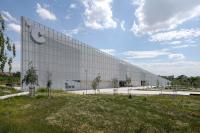House with the warped court
Surat, インド
In the heart of the industrial city of Surat; with a recent history of plague, riots, earthquake, and floods; and dealing with the side effects of industrialization, is the 2650 square meter oddly shaped plot for housing a migrant diamantaire, his textile designer wife, two sons, and aging parents; and a large collection of art. The challenge was to provide the family a space into which they could retreat and not become a spectacle for the high-rise buildings all around.
The intention was to use traditional design solutions, one of which is to centre the spaces around a courtyard that provides a reclusive family area also benefiting the micro-climate of the house. The other was to use “haveli” inspired closed outer shell and hollow insides. Irregular site lines act to generate a skewed wood form finished concrete box that encloses the house and provides a vision, climate and noise buffer. These lines also help in making the best of the required margin space, engendering individuated clear and green spaces on all sides of the house enjoyed through the selective openings into these landscape gems.
The spatial resolution is attained by composing the court with a ramp, a stair and a lift on its four corners. All radiating site lines converge on a lone frangipani tree in the courtyard. This tree acts as the navel – ‘the cosmic axis of energy concentration’.
As one enters, an encounter with a large entrance veranda immediately shuts out the view of the outside, leaving behind bamboo, water and shafts of light on the rough walls overflowing into the house from the low height openings. The formal living-dining space as well as the adjoining pavilion overlooking a line of almond trees can be accessed from here. The formal entrance is across the passage from the family entrance, both in close proximity to the kitchen which is placed on corner assuming an important position in this type where the lady of the home supervises the cooking. The staircase next to the living space and kitchen takes us to the private areas and a study above those on the ground floor, a patio and another pavilion overlooking the courtyard below.
Back downstairs, the overlapping of individual family member’s routines converge around the courtyard creating a space at the centre of the house which often becomes the hub of family life. The lady of the house moves between the Burma-teak-clad bedrooms and the kitchen; while her husband attends to his associates and guests in the travertine-clad drawing room with its outdoor veranda overlooking the tranquil green behind the house. The older grandson enjoys the water-filled all-concrete subterranean Jacuzzi with his friends, while his grandfather spends his evenings near the lift enjoying the gentle draught of the air rising towards the heated lift tower. The grandmother relaxes in the family veranda keeping an eye on the youngest grandson who plays in and around the red sandstone court, owning the house the most.
The compressed veranda spaces, double height formal living and dining, the elevated entrance walkways, and the open to sky court form diverse spaces within the house. These ‘nature-trapping’ volumes along with the ‘site induced’ angles of the walls and the ‘use derived’ materials for different areas results in a chimerical, constantly-adapting environment. The house seems to transform as the changing sunlight falls on surfaces throughout the day, rain water flows down the rough textured material like a cascade in monsoons, the chime of the swaying bamboos on a breezy day, and the eternal calmness of the Frangipani tree, like a living organism with its heart placed in the courtyard; all help in turning small everyday occurrences into eternal celebrations.
- 場所
- Surat, インド
- 年
- 2005














